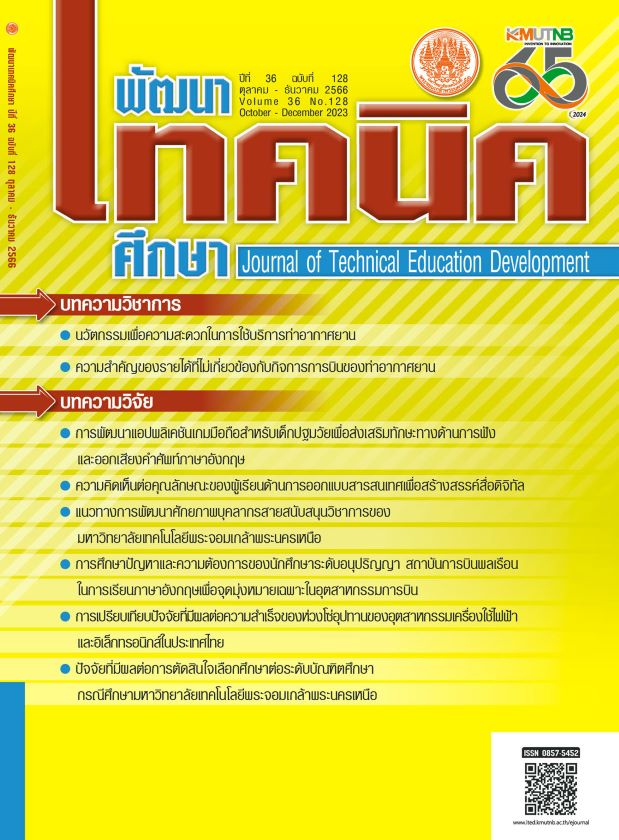นวัตกรรมเพื่อความสะดวกในการใช้บริการท่าอากาศยาน
Main Article Content
บทคัดย่อ
บทความวิชาการฉบับนี้ นี้มุ่งศึกษาเรื่องนวัตกรรมเพื่อความสะดวกในการใช้บริการท่าอากาศยาน เพื่อเป็นแนวทางในการลดความแออัดและเพิ่มความสะดวกในการใช้ท่าอากาศยาน เนื่องจากในปัจจุบันนี้มีแนวโน้มอัตราการเข้าใช้บริการภายในท่าอากาศยานที่เพิ่มมากขึ้น ซึ่งแนวโน้มนี้อาจทำให้อัตราการใช้บริการท่าอากาศยานเกินขีดความสามารถในการรองรับผู้โดยสารทั้งหมดได้ เพื่อให้บรรลุวัตถุประสงค์ของการแก้ไขปัญหานี้จึงได้มีนักวิชาการคิดค้นและพัฒนานวัตกรรมใหม่ ๆ ซึ่งสามารถนำมาปรับใช้หรือนำมาแก้ปัญหาที่เกิดขึ้นจากการใช้บริการที่เพิ่มมากขึ้นจึงทำให้การใช้บริการในจุดต่าง ๆ มีสภาพที่คล่องตัวมากขึ้น จากการศึกษาพบว่า นวัตกรรมที่นักวิชาการได้คิดค้นขึ้นมาในปัจจุบันนั้นสามารถแก้ไขปัญหาความล่าช้าหรือความไม่สะดวกในการใช้บริการ ท่าอาศยาน ได้อย่างมีประสิทธิภาพ ตัวอย่างเช่น การติดตั้งตู้เช็คอินและรับบอร์ดดิงพาสได้ด้วยตัวเอง (Kiosk) รถเข็นอัจฉริยะสำหรับผู้ที่ไม่สะดวกในการยืนหรือเดินได้ด้วยตัวเอง (Smart Wheelchair) รถดันอัจฉริยะ (Smart Electronic Tug) นวัตกรรมเหล่านี้และอีกมากมาย ผู้อ่านสามารถค้นคว้าศึกษาได้จากบทความทางวิชาการฉบับนี้ เพื่อประโยชน์ในด้านความรู้ทางนวัตกรรมและจะสามารถนำไปปรับใช้ต่อการใช้บริการภายในท่าอากาศยานได้อย่างแท้จริง
Article Details

อนุญาตภายใต้เงื่อนไข Creative Commons Attribution-NonCommercial-NoDerivatives 4.0 International License.
เอกสารอ้างอิง
Sullivan, D., & Dooley, L. (2008). Applying innovation. Sage publications.
CAAT. (2019). [online]. สถิติจำนวนผู้โดยสารและเที่ยวบินภาพรวมทั่วประเทศ. [Retrieved on 3 April 2021]. From: https://www.caat.or.th/wp-content/uploads/2020/02/
Kalakou, S., & Macário, R. (2013). An innovative framework for the study and structure of airport business models. Case Studies on Transport Policy, 1(1-2), 2-17.
Kaljakina, K. (2018). From the airport to the city centre: GoSleep Pod as a part of pop-up hotel concept.
Kahn, K. B. (2018). Understanding innovation. Business Horizons, 61(3), 453-460.
Kazda, A., & Caves, R. E. (2007). Airport design and operation (Vol. 2). Amsterdam: Elsevier.
Booranakittipinyo, A. (2020). Identifying Airport Service Quality Driving Factors: A Case of an International Airport in Bangkok. RICE Journal of Creative Entrepreneurship and Management, 1(1), 1-20.
Kennedy, W. R., Amacher, A. G., & McLaughlin, G. C. (2017). Dubai-The Epicenter of Modern Innovation: A Guide to Implementing Innovation Strategies. CRC Press.
Chen, J. K., Batchuluun, A., & Batnasan, J. (2015). Services innovation impact to customer satisfaction and customer value enhancement in airport. Technology in Society, 43,
-230.
Senay, M. (2018). Transfer passengers’ perception of service innovations at hub airports: Munich International, Seoul Incheon, and Singapore Changi Airport (Master's thesis, University of Malta).
Cash, S., Zhou, Q., Olatunbosun, O., Xu, H., Davis, S., & Shaw, R. (2019). Development of a Series Hybrid Electric Aircraft Pushback Vehicle: A Case Study. Engineering, 11(1), 33-47.
Andreatta, G., De Giovanni, L., & Monaci, M. (2014). A fast heuristic for airport ground- service equipment–and–staff allocation. Procedia-Social and Behavioral Sciences, 108, 26-36.
Dismukes, R. K. (Ed.). (2017). Human error in aviation. Routledge.
Halpern, N., Mwesiumo, D., Suau-Sanchez, P., Budd, T., & Bråthen, S. (2021). Ready for digital transformation? The effect of organisational readiness, innovation, airport size and ownership on digital change at airports. Journal of Air Transport Management, 90.
Ryley, T., Elmirghani, J., Budd, T., Miyoshi, C., Mason, K., Moxon, R., ... & Zanni, A. (2013). Sustainable development and airport surface access: The role of technological innovation and behavioral change. Sustainability, 5(4), 1617-1631.
Senay, M. (2018). Transfer passengers’ perception of service innovations at hub airports: Munich International, Seoul Incheon, and Singapore Changi Airport (Master's thesis, University of Malta).


